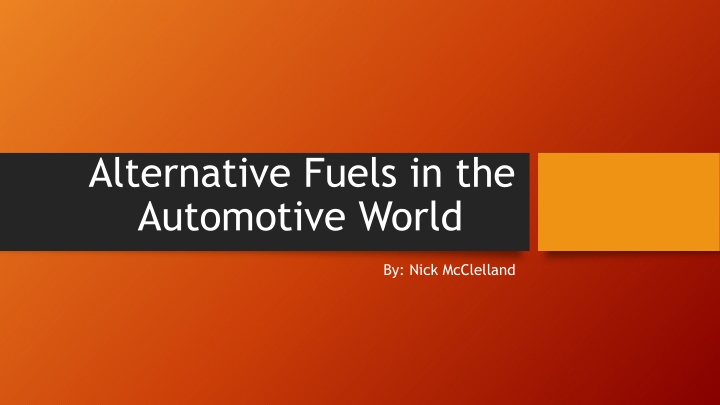
Exploring Alternative Fuels in Automotive Industry
Discover the diverse landscape of alternative fuels in the automotive world, including hydrogen, electricity, biodiesel, and ethanol. Delve into the benefits, opportunities, costs, and risks associated with each fuel type, helping in the transition away from fossil fuels.
Uploaded on | 0 Views
Download Presentation

Please find below an Image/Link to download the presentation.
The content on the website is provided AS IS for your information and personal use only. It may not be sold, licensed, or shared on other websites without obtaining consent from the author. If you encounter any issues during the download, it is possible that the publisher has removed the file from their server.
You are allowed to download the files provided on this website for personal or commercial use, subject to the condition that they are used lawfully. All files are the property of their respective owners.
The content on the website is provided AS IS for your information and personal use only. It may not be sold, licensed, or shared on other websites without obtaining consent from the author.
E N D
Presentation Transcript
Alternative Fuels in the Automotive World By: Nick McClelland
Background Alternative fuels are increasingly becoming a popular topic among many industries, including the auto industry Current research in alternative fuels o Hydrogen/Fuel cell o Electric Vehicles o Biodiesel o Ethanol Cars powered by alternative fuels o Tesla (electricity) o Nissan Leaf (electricity) o Honda FCX Clarity (Fuel Cell)
Alternatives Four different types of alternative fuels Hydrogen/Fuel Cell Electricity Biodiesel Ethanol The question to ask Which of the alternative fuel technologies should the auto industry pursue as we transition away from our reliance on fossil fuels?
Ratings Benefits Opportunities Costs Risks Hydrogen/Fuel Cell Excellent Excellent Above Average Above Average Electricity Above Average Average Average Below Average Biodiesel Average Average Excellent Below Average Ethanol Below Average Average Average Average Priorities .524 .169 .201 .106
Benefits Criteria Control Criteria Economic Sub-criteria Consumer Availability Cost to Implement Cost to sustain Description Economic infrastructure of USA How cheap it is to implement new fuel source How cheap it is to sustain the fuel source Social Brand Recognition Social Status Popularity of specific car brands Social standing Environmental Low Emissions How much are emissions reduced Energy Energy efficiency of new fuel source
Opportunities Criteria Control Criteria Sub-criteria Description Environmental Pollution How much pollution can be reduced Energy Usage Reduction Reduced Energy Consumption How much energy can be conserved with new fuel source Technological Advancement Fuel Tech Usage In Other Industries The ability for the new fuel source to advance other industries
Costs Criteria Control Criteria Economic Sub-criteria Legislation Infrastructure Profitability Job Availability Description Cost of legislation required for new fuel source Cost of restructuring of industry infrastructure The ability to retain profits from new fuel source Amount of available jobs for people Resource Availability Patents Cost of obtaining the patents to implement new fuel source Cost of obtaining necessary physical materials Physical Materials Implementation Cost to Implement Cost of implementing new fuel system and fueling stations
Risks Criteria Control Criteria Consumer Reaction Public reception Sub-criteria Description How enthusiastic the public is for new fuel source How safe is the driver when using the new fuel source How much might sales decrease How much may production of vehicles be reduced How much may profit margins be reduced Driver Safety Safety of Driver Auto Industry Disruption Decreased Sales Decreased Production Decreased Profit Margins Job Availability Decrease in Auto- Industry Jobs How much may job availability be reduced
Criteria and Priorities: Benefits Local Priorities Global Priorities Merit Criteria Sub-criteria Benefit Economic Consumer Availability 0.67 .0456 0.37218 0.183 Cost to Implement 0.11 .0075 Cost to Sustain 0.222 .015 Social Brand Recognition 0.263 .0074 0.0752 Social Status 0.079 .0022 Car Ownership 0.659 .0184 Environmental Low Emissions 0.800 .221 0.741 Energy 0.200 .0552
Criteria and Priorities: Risks Consumer Reaction Local Global Priorities Risks Priorities .10558 .60922 Driver Safety 1.0 .064 Public Reception .08671 Auto Industry Disruption Safety of Driver 1.0 .009 Decreased Sales .34455 .008 0.22176 Decreased Production Decreased Profit Margins .10852 .54693 .003 .012 Job Availability .08231 Decrease in Auto-Industry Jobs 1.0 .009
Decision Network Benefit
Decision Network Opportunities
Decision Network Cost
Decision Network Risks
Sensitivity Analysis Hydrogen/Fuel cell technology was the best choice in every category Opportunities oBiodiesel is second best alternative oElectric becomes the second best alternative as time goes on Risks oInitially ethanol and electric have equal risk, but as time went on electricity proves to have fewer risks associated with it when compared to ethanol
Conclusion The model supports Hydrogen/Fuel Cell technology for a long-term decision The model strongly supports the Ethanol alternative for a short-term solution Hydrogen/Fuel Cell technology has the best benefits and opportunities with minimal risks or costs Ethanol is a strong short-term solution due to its ability to work on many cars on the road today, as well as ease our reliance on fossil fuels
